Physical Address
304 North Cardinal St.
Dorchester Center, MA 02124
Access video lecture content for this chapter online at Elsevier eBooks+ ![]()
The pathogenesis of facial aging is largely explained on an anatomical basis, particularly the variations in the onset and outcome of aging seen in different individuals. Surgical anatomy is a particular branch of anatomy that focuses on specific surgical objectives. In contrast, traditional anatomy deals with bodily structure from an evolutionary and comparative perspective. Understanding of ambiguous dissection findings is explained by these related aspects.
This chapter is on surgical anatomy of the face as it relates to the performance of facelifts. An anatomical approach to surgical rejuvenation of the face provides the way of obtaining a ‘natural’ result that is safe, with minimal morbidity and results that are lasting ( ).
Fundamental to safety when operating in the face is the surgeon having a firm grounding in the principles on which the facial soft tissue layers are constructed. Understanding of the facial nerve branches and their relation to the soft tissue layers, retaining ligaments and soft tissue spaces is crucial in predicting the location of the facial nerves. This is most important in addressing the overriding concern when performing surgery, the course and location of the facial nerve branches. The development of facial laxity with aging of the face occurs primarily in the mobile superficial fascia, immediately superficial to the ‘deep plane’ or layer 4 as will be described. A core principle of plastic surgery, as advocated by Pare, is to ‘ restore to their place things which are displaced ’. Many facelift techniques have been utilized using various planes of dissection. Operating in the surgical plane is therefore the logical plane to dissect in facelifts. The surgical anatomy described here is intended for surgeons to enhance their ability and margin of safety when performing deep plane facelift surgery.
The traditional approach to assessing the face is to consider the face in thirds (upper, middle and lower thirds). While useful in selecting surgical procedures to address the patient’s concerns, this approach limits conceptualization, as it is not based on the function of the face. From a functional perspective, the face has an anterior aspect and a lateral aspect, which is distinctively different. The anterior face, which is the face proper, is highly evolved for communication, including facial expression. In contrast, the lateral face, which is concealed by hair in most animals including non-human primates, essentially covers the structures involved in mastication. A vertical line descending from the lateral orbital rim is the approximate division between the lateral and the anterior face. This corresponds internally with a series of facial retaining ligaments located along this line, which provide the structural basis for the demarcation ( Fig. 9.2.1 ). The mimetic muscles of the face are located within the superficial fascia of the anterior face, predominantly in relation to the eyes and the mouth. This highly mobile area of the face is designed to allow fine movement, which predisposes it to the development of laxity with aging. In contrast, the lateral face is relatively immobile as it passively overlies the structures to do with mastication, which are located in relation to the deep fascia, the temporalis and masseter muscles, with the parotid gland and its duct. The only significant superficial muscle in the lateral face is the platysma in the lower third, which extends up to the level of the oral commissure.
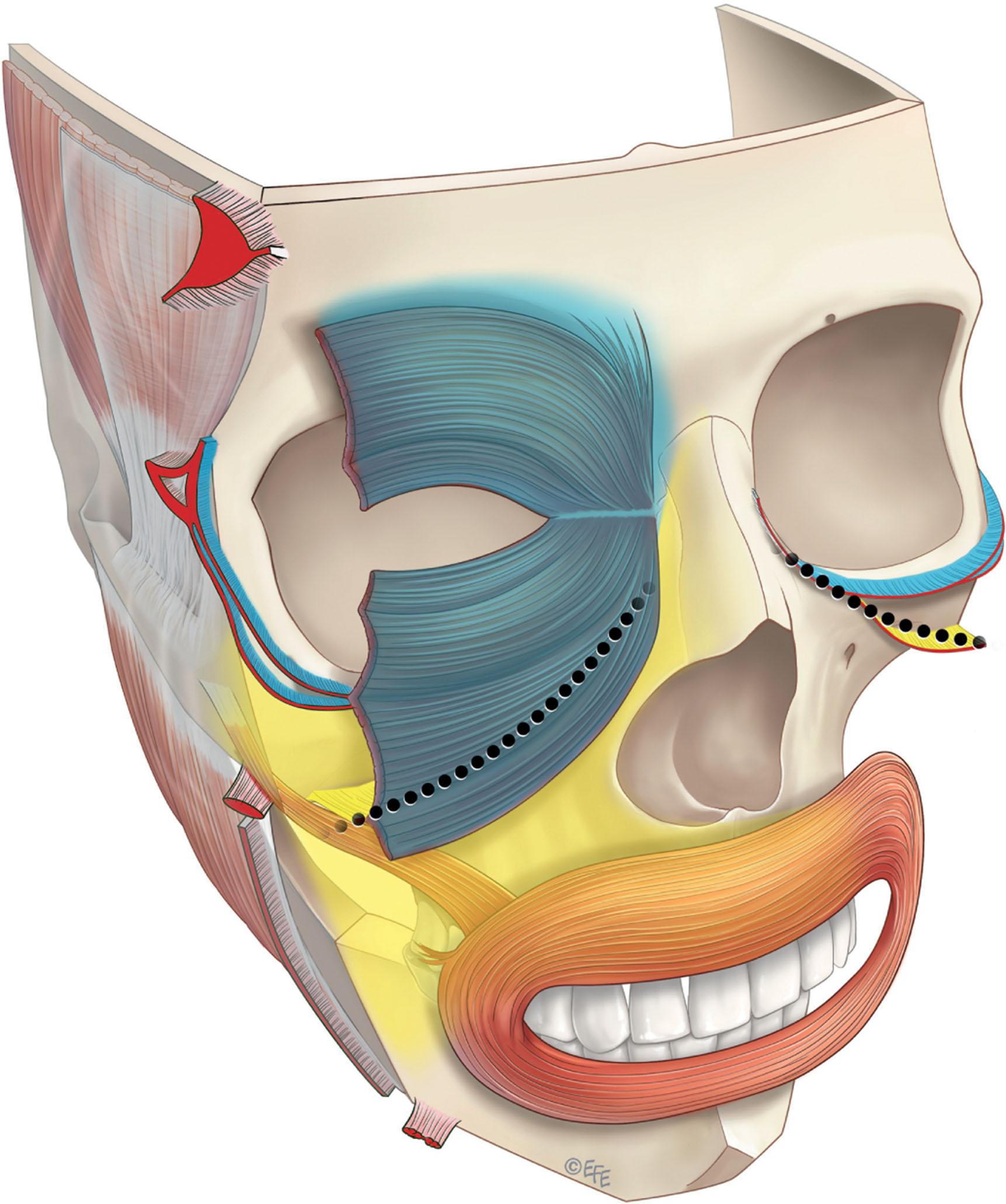
The soft tissues of the anterior face should be considered in two parts: (A) the part that overlies the skeleton proper; and (B) the highly specialized sphincters that overlie the bony cavities. The soft tissues that overlie the orbital and oral cavities are modified, as the cavities cannot have a deep fascia layer to provide support. An adaption is needed to compensate for this absence of usual support from behind. From necessity, the support comes from a system of specialized retaining ligaments attaching to the rim of the bony cavities. The fixation at the transition zones (between areas that overlie the skeleton and the bony cavities) is not apparent in youth, but become increasingly evident with aging.
Conceptually the facial soft tissues are organized in five concentric layers: (1) skin; (2) subcutaneous tissue; (3) musculo-aponeurotic layer; (4) loose areola tissue; (5) deep fascia. Significantly, the layers are not uniform across the face. Each layer varies in thickness according to the particular type of contained tissue, in accordance with the specific function of the region. Even the skin, the simplest layer to understand, is not homogeneous. The thickness of its epidermis and dermis varies according to the region of the face. The principles of the five-layered arrangement are most clearly understood by studying the scalp and forehead, whose soft tissues have been ‘distended’, as a consequence of the evolutionary expansion of the underlying cranial vault (necessary to accommodate the highly developed frontal lobe in humans) ( Fig. 9.2.2 ). Layer 4 (the loose areolar tissue) is the layer that allows the superficial fascia (defined as the composite flap of layers 1 through 3) to glide over the deep fascia (layer 5), as noted with facial expression. For example, the frontalis functions independent of the deeper muscle of mastication, the temporalis. The ‘simplified’ anatomy over the scalp gives the basic prototype of layer 4. For the most part, this plane is essentially an avascular gliding plane space. At the boundaries of the scalp across the supraorbital rim and along the superior temporal lines, the scalp of the forehead is firmly anchored by ligamentous attachments to the periosteum. Vital structures, the nerves, vessels and lymphatics, are not in the ‘space’, but are located in close proximity to the retaining ligaments when transitioning in their course from deep to superficial.
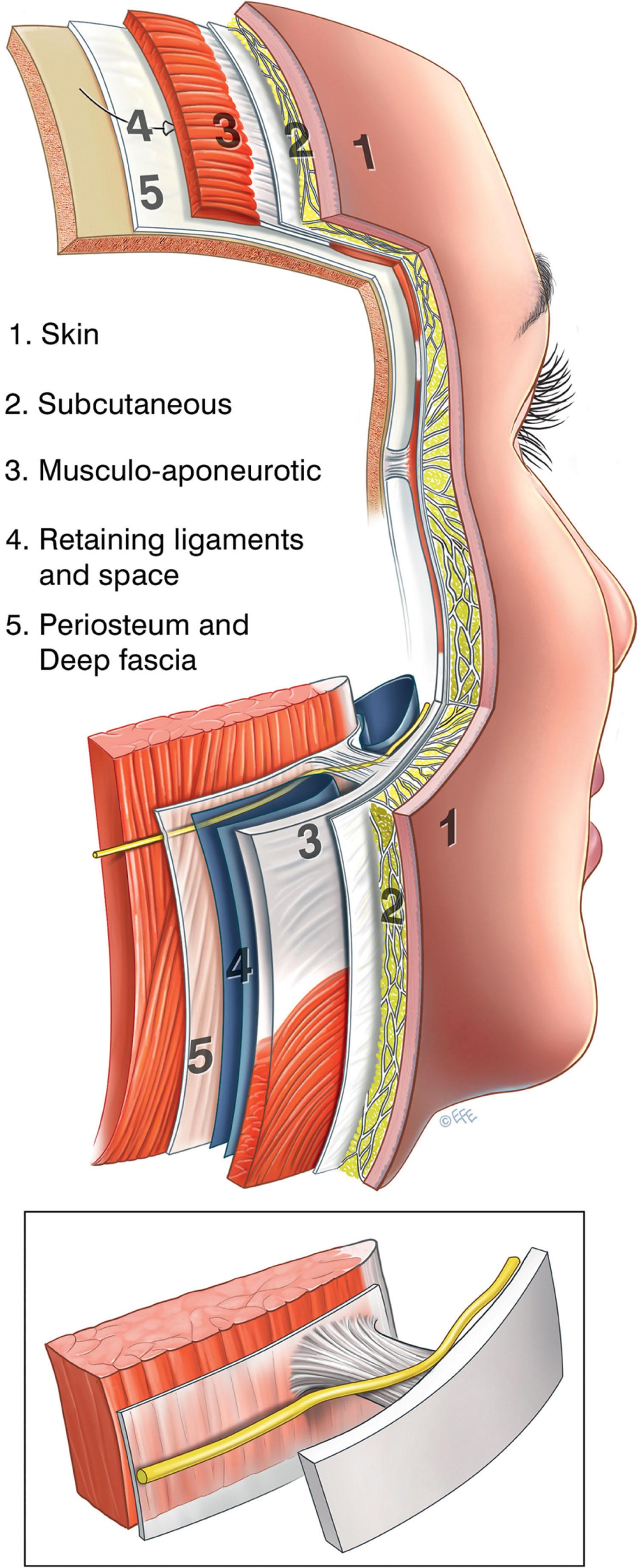
The principles of construction remain the same in other parts of the face, although with greater complexity. This relates to the evolutionary compaction of the midface structure due to the absence of forward projection of the human mid face (as is present in other species) as well as the prominence of the orbital and oral cavities at the expense of solid bone. This reduces the amount of bony platform available for the attachment of muscles and retaining ligaments. The five soft tissue layers are secured to the facial skeleton by an elaborate system of retaining ligaments that bind the dermis to the skeleton (or deep muscle fascia, where the facial skeleton is covered by the muscles for mastication). The components of this multi-linked fibrous support system pass through all layers ( Figs. 9.2.3 & 9.2.4 ).
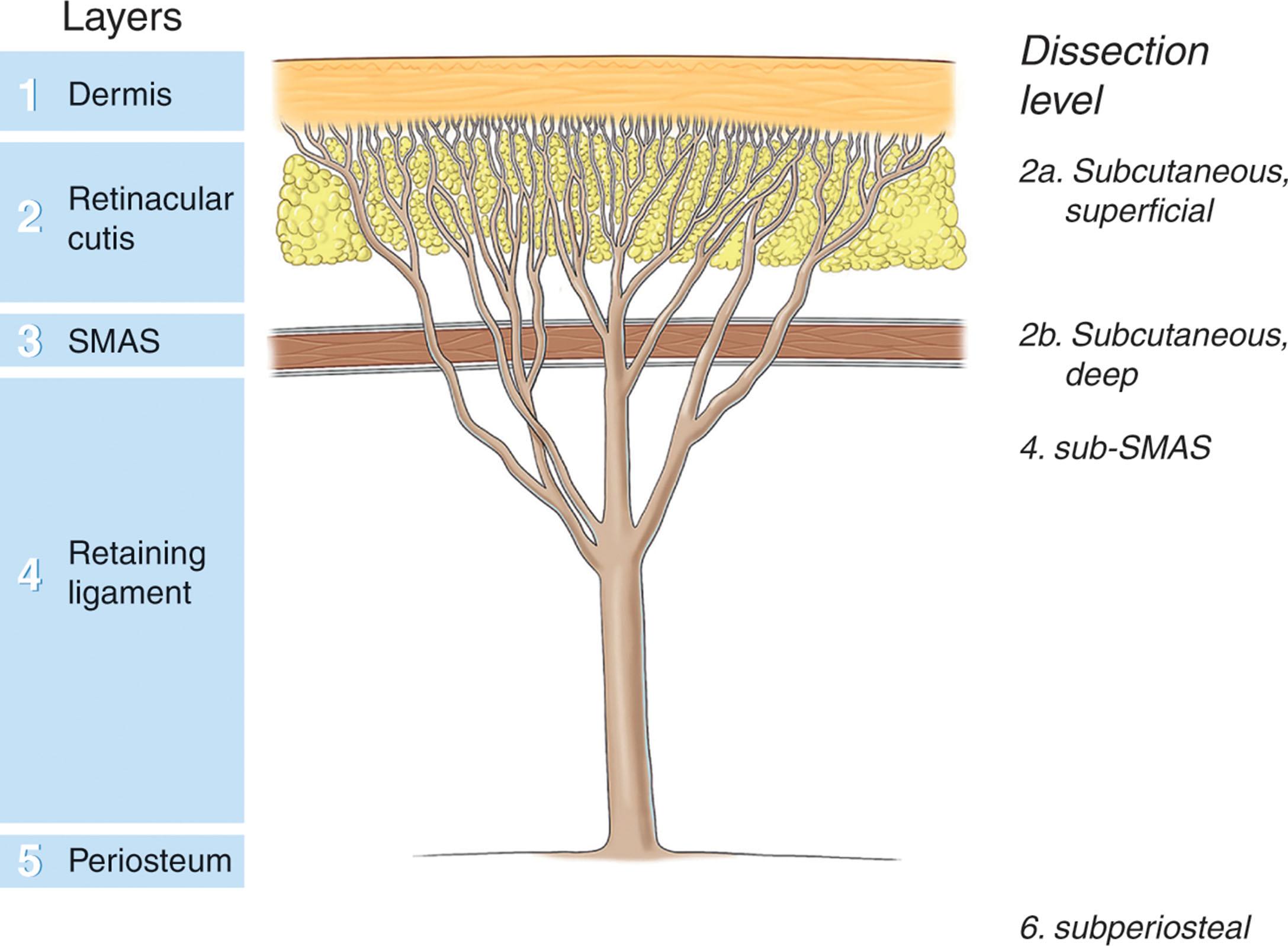
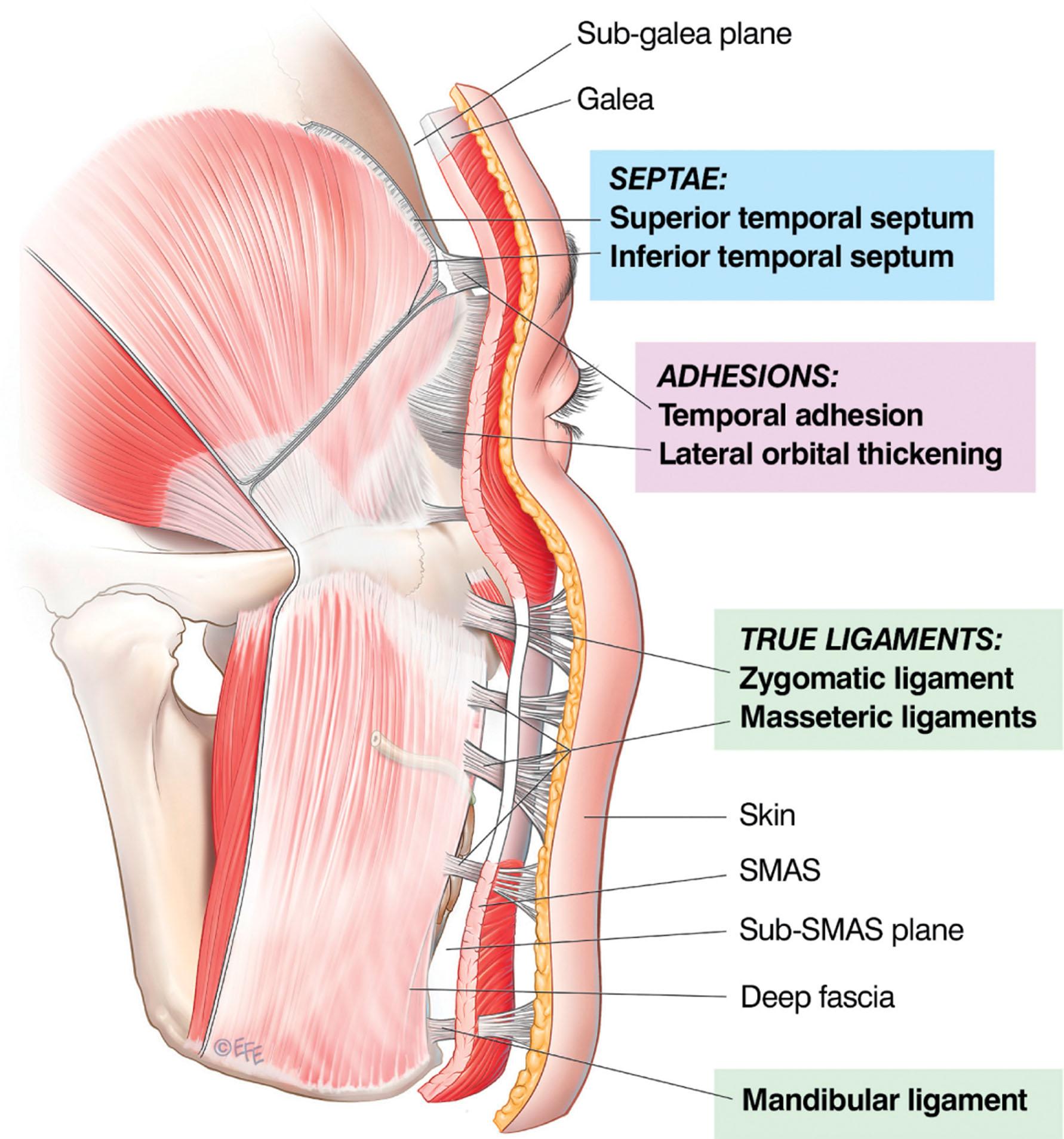
The descriptive terms layer and level are used almost interchangeably, although having a somewhat different connotation. The plane of surgical dissection of a target support layer, such as the SMAS (layer 3), is not within the layer but at a level above (deep subcutaneous level, layer 2) or below (in layer 4), or both (see Fig. 9.2.3 ). Layers 2 and 4 are the dissection layers and in them the surgical dissection level may be superficial or deep.
The epidermis is a cell-rich layer composed mainly of differentiating keratinocytes and a smaller number of pigment-producing melanocytes and antigen-presenting Langerhans cells. A rich vascular plexus is an important component of the dermis. The thickness of the dermis relates to its function and tends to be inversely proportionate to its mobility. The dermis is thinnest in the eyelids and thickest over the forehead and the nasal tip. The thinner the dermis, the more susceptible it is to qualitative deterioration aging changes like wrinkling and creases formation.
The subcutaneous layer has two components: the subcutaneous fat, which provides volume, and the fibrous retinacular cutis that binds the dermis to the underlying superficial musculo-aponeurotic system (SMAS) of the face. Of note, the retinacular cutis is the name given to that part of the retaining ligament that passes through the subcutaneous tissues. The amount, proportion and arrangement of each component varies in different regions of the face. In the scalp, the subcutaneous layer has uniform thickness and consistency of fixation to the overlying dermis. In contrast, in the face proper, the subcutaneous layer has significant variations in thickness and attachments. In highly specialized mobile areas, such as the eyelids and lips, the subcutaneous layer is significantly compacted such that fat may appear non-existent. In other areas, such as the nasolabial segment, it is thick. In areas with thick subcutaneous tissue, the retinacular cutis lengthens significantly, predisposing its fibers to distention and weakening with aging. Within the subcutaneous tissue, the overall attachment to the overlying dermis is stronger and denser than the attachment to the underlying SMAS.
This is a result of the tree-like arrangement of the retinacular cutis fibers (see Fig. 9.2.3 ), with fewer but thicker fibers deep as its rises through the SMAS then progressively divides into multiple fine microligaments as they reach the dermis. This explains why dissection is easier to perform at the deep subcutaneous level (just on the surface of the underlying SMAS) than more superficially nearer the dermis, as there are fewer retinacular cutis fibers and the subcutaneous fat here does not attach directly to the outer surface of the underlying SMAS.
Furthermore, the retinacular cutis fibers are not uniform across the face. They vary in orientation and density according to the anatomy of the underlying deeper structures. As will be apparent when the anatomy of the underlying layer 4 is described, at the location of the retaining ligaments, the vertically oriented retinacular cutis fibers are most dense and are the most effective in supporting for the overlying soft tissues and in so doing, forms boundaries that compartmentalize the subcutaneous fat. These areas, such as the so-called McGregor’s patch over the body of the zygoma, often require sharp release to mobilize. In between these retaining ligaments in layer 4 are located the soft tissue spaces of the face, that facilitate the mobility of the superficial fascia over the deep fascia. Where the subcutaneous fat overlies a space, the retinacular fibers are less dense and oriented more horizontally. This has a surgical significance as the tissues tend to separate with relative ease, often with just simple blunt finger dissection ( Fig. 9.2.5 ). The variation in the density and orientation of the retinacular cutis fibers in the subcutaneous fat is the anatomical basis for the ‘superficial subcutaneous fat’ compartments. Dye injection into the subcutaneous fat results in staining of the fat in discrete compartments. While the relevance of superficial subcutaneous fat compartments remains debated, anatomically, the compartments are defined by their retaining ligaments boundaries.
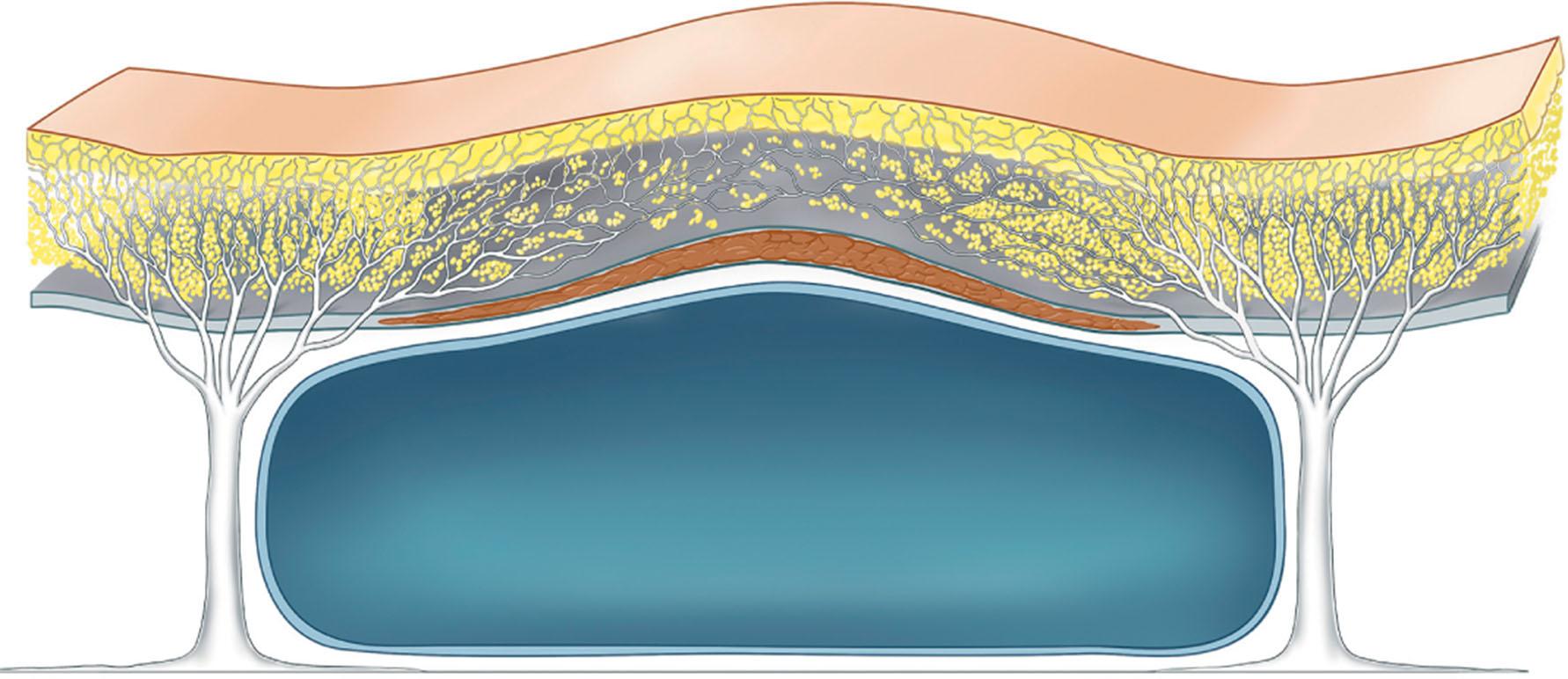
The muscles of facial expression are unique and fundamentally different from skeletal muscles beneath the deep fascia because of their situation within the superficial fascia and the tissues they move are not bone but the soft tissues of which they are a part. All muscles of facial expression have either all or the majority of their course within layer 3. They are predominantly located over and around the orbital and oral cavities. In the prototype scalp, the occipital-frontalis moves the overlying soft tissue of the forehead, while its undersurface glides over the subgaleal aponeurotic space (layer 4). Layer 3 is continuous over the entire face, although for descriptive purposes, different names are given to certain parts according to the superficial muscle within. It is called the galea over the scalp, the temporoparietal (superficial temporal) fascia over the temple, the orbicularis fascia in the periorbital region, the SMAS over the mid and lower face and platysma in the neck.
Within layer 3, the facial muscles themselves have a layered configuration, with the broad, flat muscles forming the superficial layer over the anterior aspect of the face. The frontalis covers the upper third, orbicularis oculi the middle third and the platysma the lower third. The muscles of this superficial muscle layer have minimal direct attachment to the bone. They are stabilized indirectly to the skeleton by the vertically oriented retaining ligaments at their periphery, as noted earlier. The frontalis is fixed along the superior temporal line by the superior temporal septum, the orbicularis oculi laterally by the lateral orbital thickening and the orbicularis retaining ligament, and the platysma at its upper border by the lower key masseteric ligament and medially by its mandibular attachment. The deeper muscles in layer 3 have bony origins to provide greater functional control of the sphincters over the bony cavities. Particularly around the mouth, the dynamic aperture of the expansile oral cavity, which has elevators (zygomaticus major and minor, levator labii superioris, levator anguli oris). Levator labii superioris alaeque nasi and depressor muscles (depressor anguli oris, depressor labii inferioris) and mentalis. In relation to the orbital cavity, deep muscles are limited to the corrugator supercilii and procerus.
Layer 4 is the plane in which dissection is performed in subSMAS facelifts, aptly named by Hamra as the deep plane . It is a layer of significant complexity that contains the following structures: (1) soft tissue spaces; (2) retaining ligaments; (3) deep part of the intrinsic muscles, where passing from their more definitive superficial soft tissue position to obtain a deeper (level 5) bone attachment; and (4) facial nerve branches, passing from deep to superficial. Functionally, there is a series of soft tissue spaces in layer 4 that allow for movement of the periorbital and perioral muscle of facial expressions (located in the roof of the spaces) independent of the major muscles of mastication, which are beneath the deep fascia floor of the spaces.
The retaining ligaments of the face are strategically placed within the boundaries between the soft tissue spaces ( Fig. 9.2.6 ). In the lateral face, immediately in front of the ear, extending 25 to 30 mm forward of the ear cartilage to the posterior border of the platysma, is a broad area of ligamentous attachment, described by Furnas as the platysma auricular fascia (PAF). As no active facial expression occurs in this region, the dermis, subcutaneous tissue, aponeurotic part of the SMAS and the underlying parotid capsule (layers 1 to 5) are bound together as an area of retaining ligament. Layer 4 is reduced to a fibrous fusion layer, without a soft tissue space, as mobility of the superficial fascia is not required here. Whereas, in the anterior face where there is considerable movement, not only over but also around the bony cavities, the ligaments are significantly compacted and arranged around the rim of the bony cavities. The bone boundaries provide the last position where underlying deep fascia is present for ligamentous attachment. These important ligaments provide support for the mobile shutters of the cavities, the eyelids and lips. Importantly for the surgeon, the retaining ligaments also act as transition points for the facial nerve branches to pass from deep to superficial on their way to innervate their target muscles.
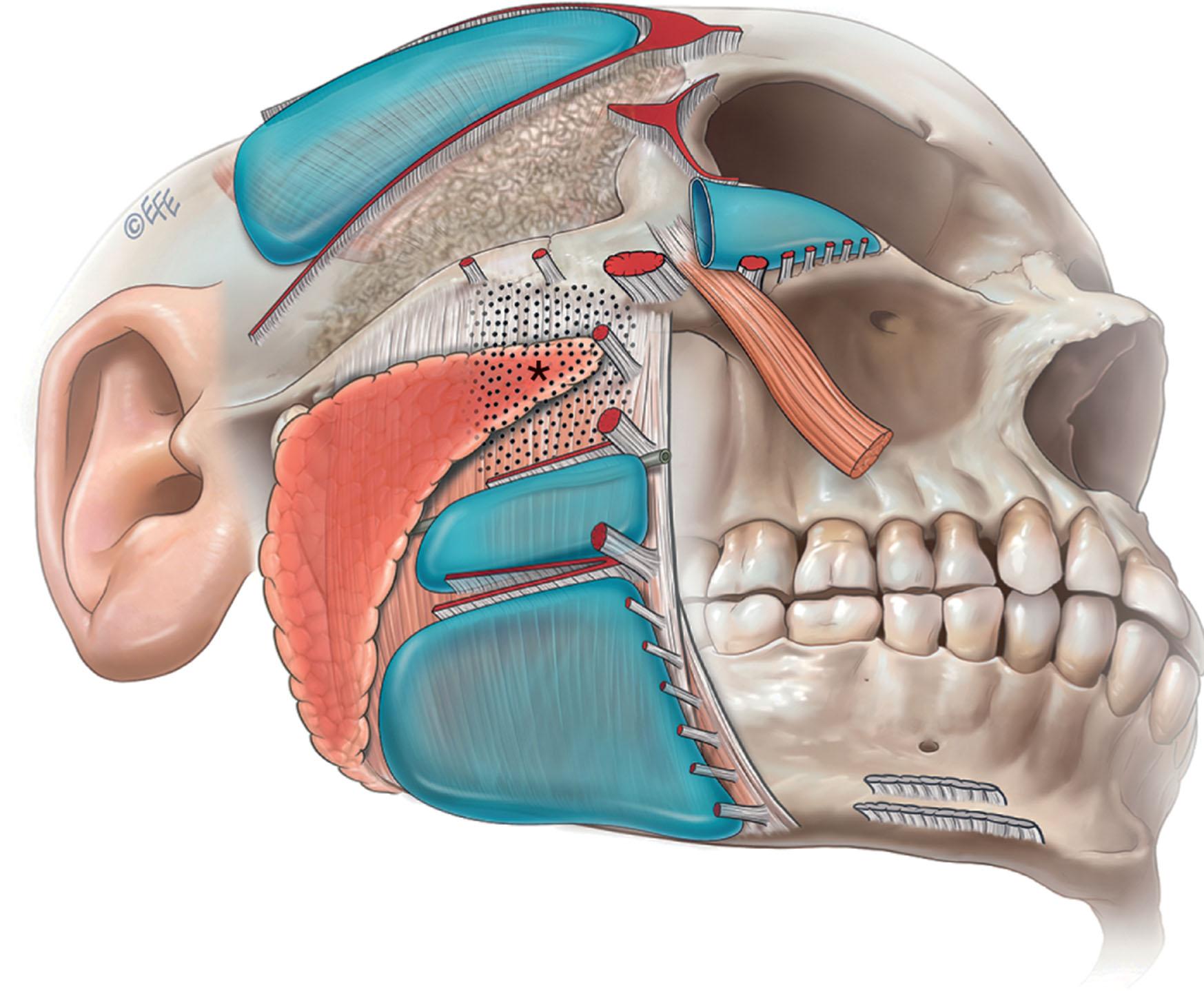
The soft tissue spaces of the face are in two forms: (1) those described overlying bone, where the spaces allow the overlying superficial fascia to glide freely over the deeper layer 5; and (2) those overlying the bony cavities, such as the preseptal space of the eyelid over the orbit and the vestibule of the oral cavity under the lips and the lower nasolabial segment of the cheek.
Of potential confusion to surgeon anatomists is the definition of deep fascia; a term used to describe the dense connective tissue related to skeletal muscles and organs. It is accepted that the superficial fascia denotes several layers based on the loose connective tissue, layer 2, linking the layer 3 muscle and the skin. According to this way of describing fasciae, the deep fascia is considered to be all the connective tissue deep to the superficial fascia. From this perspective, layer 4 as described, would be considered part of the deep fascia. However, from a surgeon’s perspective of facial anatomy, layer 4 is a well-defined transition layer that functionally separates the superficial fascia from the deep fascia.
The deep fascia, the deepest soft tissue layer of the face, has multiple components. It is formed by the periosteum where it overlies bone. Over the lateral face, where the muscle of mastication (temporalis and masseter) overlie the bone, the deep fascia is instead the fascial covering of the muscles, i.e. the deep temporal fascia and masseteric fascia. Over the anterior face there is not a deep fascia layer within the lids and lips, the mobile shutters that overlie the bony cavities. Here, the deep fascia is replaced by a mobile lining from the cavities, the conjunctiva and oral mucosa. The recently described ‘deep fat compartments’ is fat located in layer 5, having more generally been called preperiosteal fat. In the neck, the corresponding layer is the investing layer of deep cervical fascia, which covers the suprafyoid muscles and splits to form the submandibular space containing the submandibular gland. In contrast to expectation, the investing deep cervical fascia is thin, being almost translucent but tough and quite flexible, consistent with the significant mobility of the neck.
The general pattern of the five-layered anatomy is modified over the anterior face where the orbital, nasal and oral cavities are present ( Fig. 9.2.7 ). Only the superficial fascia, the outer three-layer composite, continues into the soft tissue overlying the cavities. The SMAS layer within this composite includes the sphincteric orbicularis muscles that extend to the free edge of the soft tissue aperture of the eyelids and the lips. The retaining ligaments, which are such a key feature of the five-layered anatomy, are not present over the cavities. There are functional and anatomical transitions from the relative stability over the fixed areas to the high mobility of the soft tissue shutters over the cavities. In order to support this composite, the retaining ligaments are condensed, being compacted along the bony orbital rim ( Fig. 9.2.8 ). This is the anatomical basis for the periorbital ligament around the orbit, of which the lower lid part is the orbicularis retaining (orbito-malar) ligament, which stabilizes the orbicularis oculi to the orbital rim periosteum. Around the oral cavity, the zygomatic ligaments arise from the periphery, being the body and arch of the zygoma and from the deep fascia near the medial edge of the masseter.
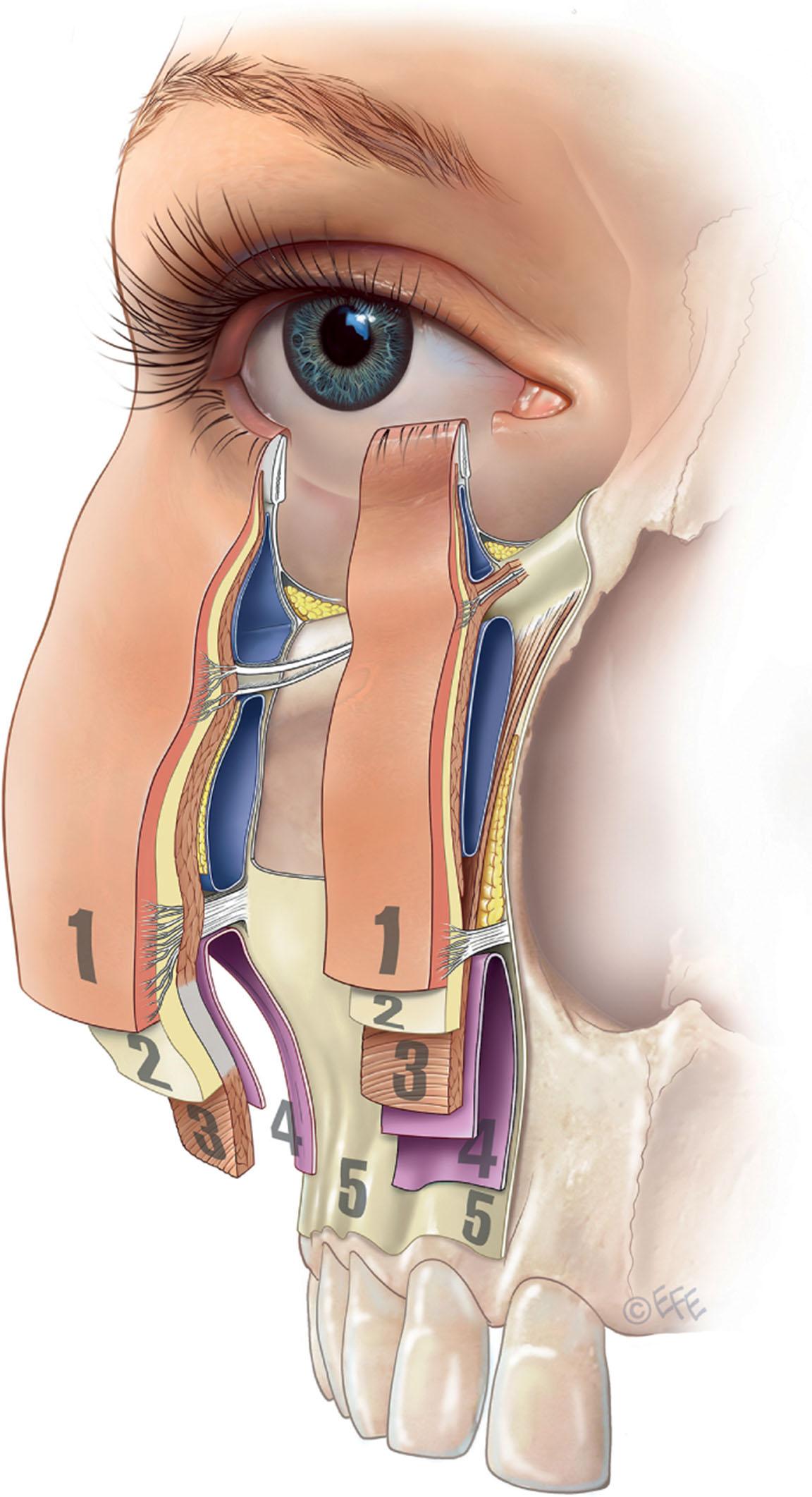
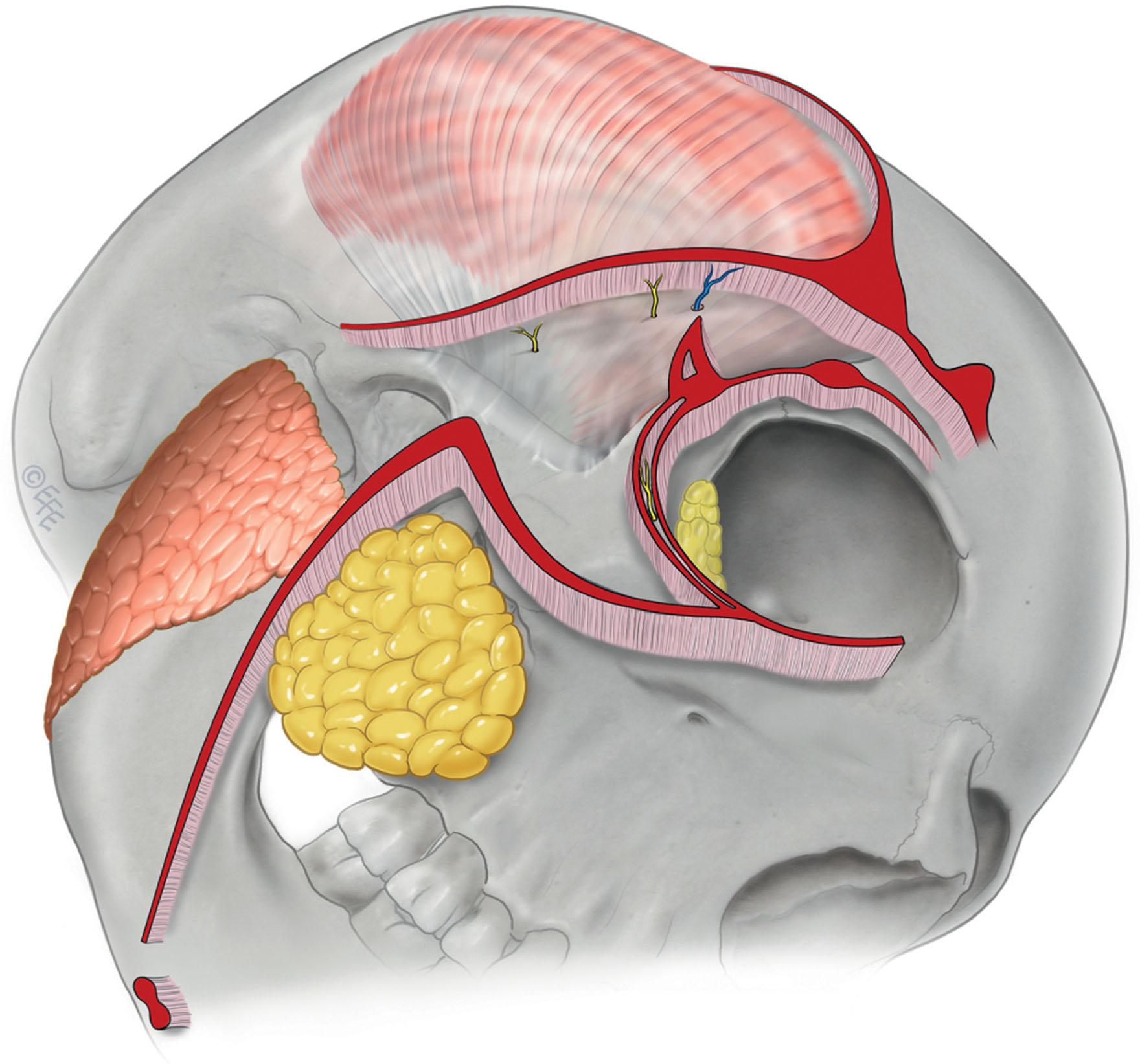
The deeper components of the eyelids and lips are derived from the cavity they cover and are not an extension of the facial soft tissues. In the eyelids, the deeper lid muscles with their related aponeurosis (levator and capsulopalpebral fasciae) and the orbital fat are retained by a fascial system, the septum orbitale. The free edges of the upper and lower eyelids obtain their ligamentous support from the tarsal plates, with their canthal tendon attachments to the medial and lateral orbital rims. In the pretarsal area, the superficial and deep lid structures, the anterior and posterior lamellae, merge. Whereas, in the preseptal part, between the pretarsal area of the lids and the orbital rim, the lamellae remain separated by a soft tissue space, the preseptal space of the lower lid, which allows movement of the preseptal orbicularis over the orbital septum. This space provides the surgeon an atraumatic and bloodless dissection plane to access the lower eyelid and the midcheek further inferiorly. There is not an equivalent space in the upper lids as the preperiosteal fat pad over the superior orbital rim continues down on the surface of the septum orbitale adherent to the fascia on the underside of the orbicularis.
The vestibule of the oral cavity overlies a significant extent of the buccal surface of the maxilla and mandible. This part of the skeleton underlying a ‘space’ is unavailable for deep ligamentous support, as ligaments cannot cross the space of the vestibule. The large area of the perioral soft tissues that overlies the extensive vestibule has compromised support. Along with the extreme mobility of the lips and, particularly, the adjacent cheek with jaw opening, these tissues are particularly susceptible to aging changes. In fact, the indication for a lower facelift is largely to correct aging laxity of this unsupported tissue.
The subSMAS layer 4 is not homogeneous, but varies significantly in the type of content according to the different functional areas. In the lateral face especially, a large component of layer 4 consists of soft tissue ‘spaces’, which allow for mobility. The spaces have defined boundaries that are reinforced in strategically important areas by retaining ligaments. Significantly, these described spaces are actually areas of loose areolar connective tissue that are anatomically ‘potential spaces’. These are easily converted to ‘surgical spaces’ by blunt surgical dissection within the loose connective tissues. Even then, the created surgical space may not necessarily extend all the way to the structural boundaries of the space. By definition these are anatomically ‘safe spaces’, as no vital structures cross within the areolar tissue space, meaning all facial nerve branches are outside these spaces.
The mobile roof is the least-supported part of the space, being more prone to developing laxity with aging, compared to the ligament-reinforced boundaries. This differential laxity accounts for much of the characteristic changes that occur with aging. Once a space has been surgically defined to its boundaries, the retaining ligaments in the boundary can then be precisely defined and released under direct vision to achieve the desired mobilization, while the vital structures closely associated with the ligaments are preserved. A brief description of the surgically significant facial soft tissue spaces follows.
In the temple overlying the temporalis muscle fascia are two compartments that are separated by the obliquely orientated inferior temporal septum ( Fig. 9.2.9 ). The upper compartment is a surgical space while the lower compartment is not a space, but an area containing important anatomy. Both compartments are interposed between the superficial temporal fascia (temporoparietal fascia) and the deep temporal fascia (temporalis muscle fascia). Anatomically, the upper compartment is an extension of the forehead anatomy down into the upper temple, while the lower compartment is an upward extension of the upper cheek anatomy into the lower temple.
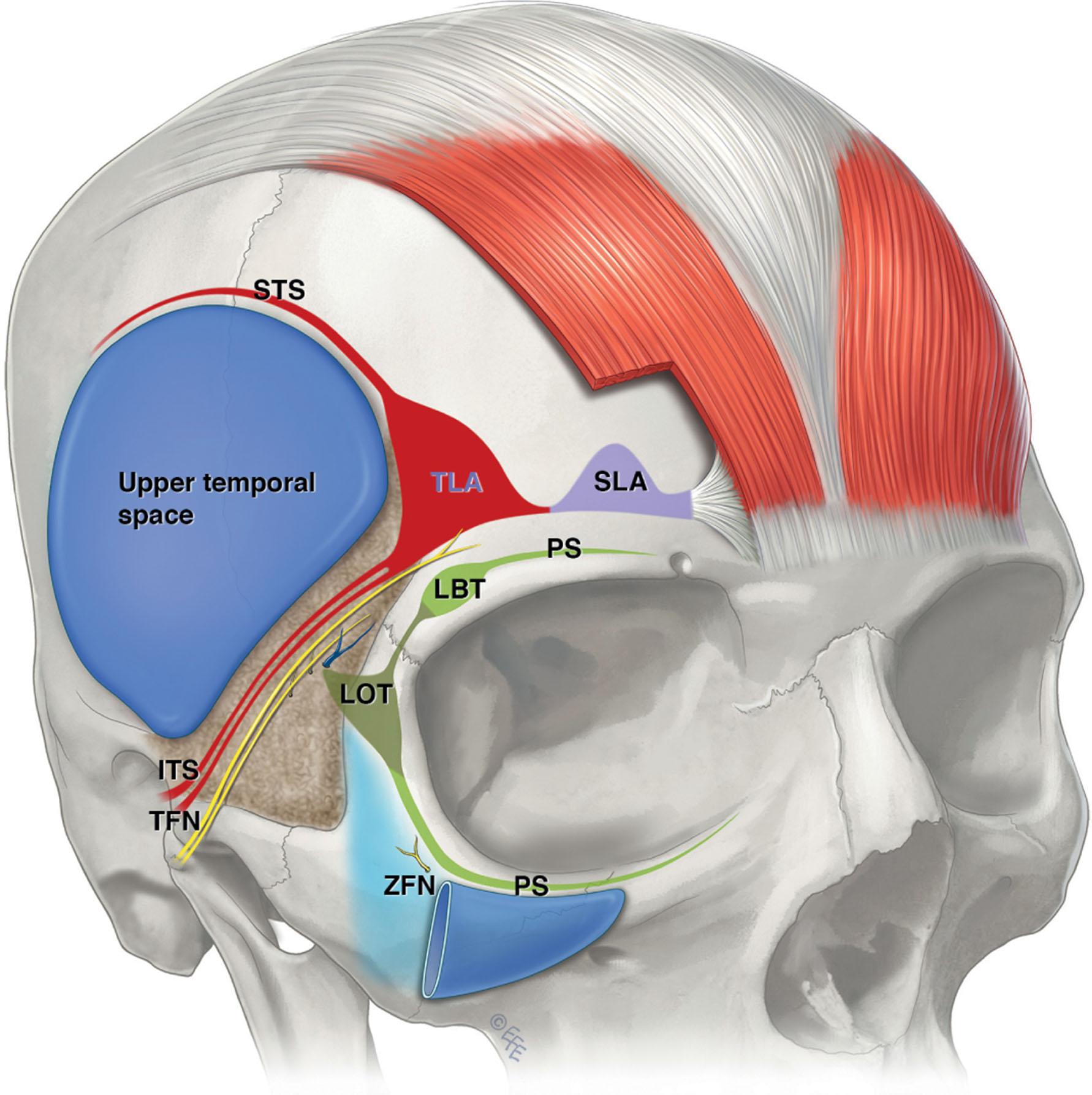
The upper temporal space is separated from the forehead by the superior temporal septum (STS) along the superior temporal line, whereas antero-inferiorly, the inferior temporal septum (ITS) separates the upper space from the triangular-shaped lower temporal area that contains important anatomy. These two septae merge anteriorly at the triangular-shaped zone of adhesion called the temporal ligament. The upper temporal space provides safe surgical access to the lateral brow and upper midcheek. The space can be readily opened by blunt dissection to its boundaries. Once identified, the boundaries can then be released by precise dissection. The STS can be released sharply, taking care only to preserve the lateral (deep) branch of the supraorbital nerve, which runs parallel to the septum about 15 mm medial to it. The ITS provides a marker to the important anatomy here as the temporal branches of the facial nerve are located parallel to and immediately inferior to this septum. To release the ITS, the ceiling of the space is gently lifted off the deep temporal fascia floor, which three-dimensionalizes the septum in preparation for gentle release at the level of the floor, bearing in mind the frontal branches are located on the underside of the temporoparietal fascia in the ceiling, under the roof of the lower temporal area. Once released, the sentinel vein comes into view. Contrary to what is suggested by its name, the sentinel vein is not necessarily a good ‘sentinel’ to warn the surgeon of the imminent proximity of the temporal branches when dissecting inferiorly from the temple approach. See further discussion in section Facial nerve branches.
Become a Clinical Tree membership for Full access and enjoy Unlimited articles
If you are a member. Log in here